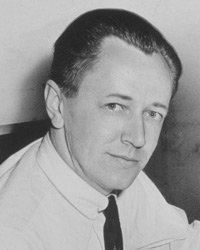Charles M. Schultz
American cartoonist (1922 - 2000)

- || At The Bottom
1950 -- Charles Schultz was fed up. The young artist from St. Paul, Minnesota, was unhappy with the treatment his work was receiving from the Pioneer Press, his hometown newspaper. For the past three years, the paper had been running a weekly series of his called "Li'l Folks," a single-panel cartoon featuring a collection of small, clever children and a beagle. He had sold a few cartoons on the side to the Saturday Evening Post, but his efforts to place "Li'l Folks" in syndication had come to nothing. Meantime, Schultz was unhappy with the $10 he received each week from the Pioneer Press and had recently asked the editors to move his work from the "women's page" to the comics section. Without much of an explanation, his requests were turned down. So Schultz decided to quit the only newspaper that seemed willing to publish his work.
- || At The Top
2000 -- When Charles Schultz announced his retirement on January 3, "Peanuts" -- the daily strip that had made him the world's most famous comic artist -- ran in more than 2600 newspapers in 75 countries, with a daily readership of 150 million. The strip's central figures, including Charlie Brown and Snoopy, had evolved from their "Li'l Folks" days into some of the most recognizable characters in popular culture, joining the likes of Mickey Mouse and Ronald McDonald as emblems of 20th century American life. The gang from "Peanuts" starred in several animated holiday specials as well as a Broadway production (You're a Good Man, Charlie Brown) that became a staple of youth theater in the United States. Thanks to Charlie Brown, Lucy, Linus, Sally, Snoopy and the rest of his creations, Schultz -- took in more than $1 billion in income during his lifetime. In 2005 -- five years after his passing -- Schultz's work was still earning $35 million a year. A lifelong hockey fan and tireless promoter of ice sports in general, Schultz was also inducted into the U.S. Hockey Hall of Fame as well as the U.S. Figure Skating Hall of fame. A few months after his death on February 13, 2000 -- the night before his last strip appeared in print -- Schultz received the Congressional Gold Medal, the highest civilian honor bestowed by Congress.
- || The Comeback
Schultz didn't have to wait long for his big break. A few months after leaving the Pioneer Press, his work was picked up by United Features Syndicate, which had rejected him several times before.. But Schultz was persistent, and UFC eventually agreed to place his new four-panel daily strip -- which they named "Peanuts" -- in seven newspapers across the country. For his first month's worth of strips, Schultz earned $90. Within eight years, the strip's popularity had grown, appearing in more than 350 papers in 40 countries. By then, Schultz and his family had relocated to Sebastopol, California, where he lived for the rest of his life. For Schultz, the key to his success rested in having a daily routine that he followed every day for decades. Every day after he woke, he had breakfast at the ice rink he and his wife had built. There, he watched the skaters before returning to his studio for a long morning session of drawing. After breaking for lunch, he returned to his studio and worked until dinner. Schultz loved his work and never wavered from his routine, even as his strip grew in popularity and branched out to include television specials, greeting cards, toys and merchandise. Though "Peanuts" made him a very wealthy man, Charles Schultz never wanted anything more than the chance to introduce his characters to an everyday readership.



